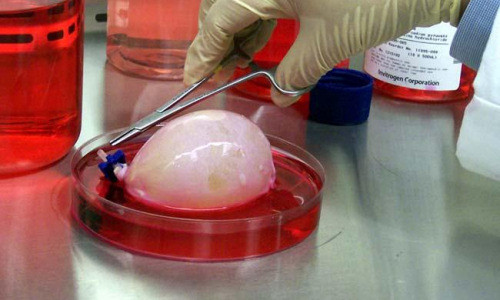Bladders engineered in the laboratory from patients’ own cells and then implanted into the body have succeeded in their first clinical trial.
The feat was accomplished by Anthony Atala, at Wake Forest University Medical School in Winston-Salem, North Carolina, and his colleagues. He says that while scientists have had success with skin transplants grown on scaffolds in the past, this is the first time they have grown and transplanted a discrete, complex organ.
The success is the culmination of an idea that the team began exploring 16 years ago. Atala adds that they are also working on growing bio-engineered hearts and pancreases in the lab. Growing organs from a patient’s own cells means the organs are not rejected after transplantation.
To create the new bladders, the researchers took a biopsy from patients whose bladders functioned poorly due to an inherited nervous system disorder. The team then placed muscle cells and cells from the bladder lining on a biodegradable bladder-shaped scaffold and allowed them to grow for about two months.
The scaffolds were made of the structural protein collagen, in some cases adding polyglycolic acid, a polymer used in surgical sutures.
Major milestone
The team then transplanted these new bladders into their patients in a delicate operation and monitored their recovery. Two of the patients did not provide follow-up information. But Atala’s group did track the progress of seven patients, aged between 4 and 19 years, for an average of nearly four years.
The patients with the bio-engineered bladders gained better urinary control. The improvements were similar to those resulting from standard surgery that relies on intestinal grafts to fix the bladder. But the new technique does not require any damage to the intestine, the researchers note.
“Atala and his colleagues should be praised for the milestone they have reached, but further multi-institutional studies are needed with longer follow-up,” writes Steve Chung, of the Advanced Urology Institute of Illinois in Spring Valley, Illinois, in a commentary on the study appearing in the Lancet. Until then, he adds, surgery using intestinal tissue to repair the bladder “remains the gold standard”.
Bladder disease does not only cause urinary control problems but can lead to kidney damage. At present, reconstructive surgery is often performed to treat severe bladder problems.
This procedure involves grafting tissue from a section of the small intestine or stomach. But medical experts say that many complications can arise from this type of procedure.
Journal reference: Lancet (DOI: 10.1016/S0140-6736(06)68438-9)
Story Source:
The above story is based on materials provided by Newscientist, Roxanne Khamsi.





